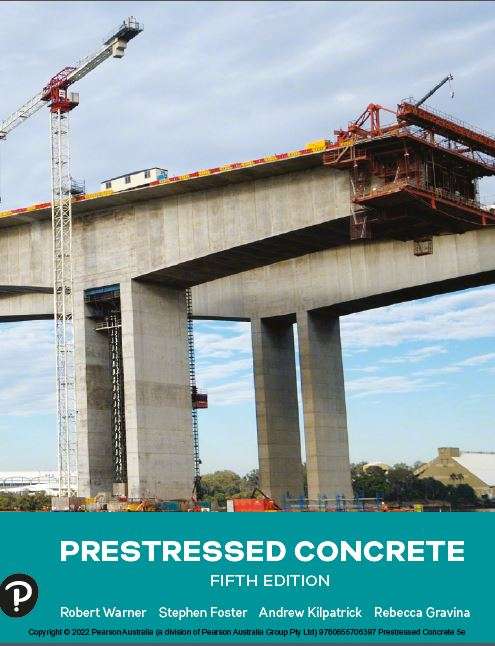Preface to the Fifth Edition
The prime purpose of this new edition of Prestressed Concrete is to take
account of important changes that have been made in the new edition of the
Australian Standard for Concrete Structures, which appeared in 2018 and
Amendment 2 in 2021. Changes include modifications to the rectangular
stress-block parameters for flexural strength calculations, modifications to
the design clauses for shear and torsion, and changes in the safety coefficients
for ultimate strength design which result in a slight reduction in the overall
safety margins for design. We have also taken the opportunity to correct
minor errors and to rearrange the material in Appendix B, which deals with
the effects of creep and shrinkage in prestressed flexural members, to make it
more directly applicable to the design process.
Robert Warner Stephen Foster Andrew Kilpatrick Rebecca Gravina
Adelaide Sydney Bendigo Melbourne
November, 2021
Preface to the Fourth Edition
Following the death of Ken Faulkes, who was an original co-author of
previous editions of this book, Rebecca Gravina has joined the team of
co-authors in the preparation of the fourth edition of Prestressed Concrete.
In this new edition we have taken the opportunity to make corrections
to the text and to extend and improve the treatment of creep
and shrinkage effects in Appendix B.
Robert Warner Stephen Foster Rebecca Gravina
Adelaide Sydney Melbourne
December, 2016
Preface to the Third Edition
When the first edition of this book appeared, more than thirty years ago, prestressed
concrete and reinforced concrete were considered to be separate and
distinct materials of construction. In Australia, different design standards had
to be used for the two materials. At that time, prestressed concrete was
designed to remain uncracked under full working load, using elastic analysis
and allowable stress concepts. The apparent gulf between reinforced concrete
and prestressed concrete was exaggerated by severe restrictions that were
placed on the use of partial prestressing by the then-current prestressed concrete
standard, AS 1481. One of the main aims of the first edition of this book
was to present a rational and unified approach to the analysis and design of
prestressed concrete, and hence to encourage designers to choose freely from
the full range of design options, including reinforced concrete and any appropriate
level of prestress. A further aim of the book was to present rational
ways of selecting prestress levels that would optimise service load behaviour
and economy. This aim was reflected in its full title: Prestressed Concrete:
with emphasis on partial prestressing1.
Today, the Australian Concrete Structures Standard, AS 3600, adopts a unified,
performance-based approach to design for all reinforced concrete structures
and members, irrespective of whether or not prestress is used. This
integrated approach has removed unnecessary restrictions on design and has
provided significant advantages to innovative designers. This in turn has
resulted in partial prestressing becoming the design norm, and the term prestressed
concrete now means, simply, structural concrete with prestress.
-
 Turnitin Instructor with AI Detection$60.00 – $110.00
Turnitin Instructor with AI Detection$60.00 – $110.00 -
 SmartPLS 4.1 Processional | Lifetime activation$60.00
SmartPLS 4.1 Processional | Lifetime activation$60.00 -
 EndNote Lifetime for Windows /Mac Software Full Version$8.00 – $10.00
EndNote Lifetime for Windows /Mac Software Full Version$8.00 – $10.00 -
![PRESTRESSED CONCRETE (5th Ed.) Robert Warner Stephen Foster Andrew Kilpatrick Rebecca Gravina 11 IBM SPSS Statistics [Lifetime]](https://civilmdc.com/wp-content/uploads/2022/11/IBM-SPSS-V-29-300x300.jpg) IBM SPSS Statistics [Lifetime]$10.00 – $25.00
IBM SPSS Statistics [Lifetime]$10.00 – $25.00 -
 LinkedIn ALL COURSES LIFETIME Warranty$40.00
LinkedIn ALL COURSES LIFETIME Warranty$40.00 -
Product on sale
 REF-N-WRITE | Premium Account Lifetime Activation$22.00
REF-N-WRITE | Premium Account Lifetime Activation$22.00 -
 QuillBot’s paraphrasing tool | Premium Account 6 month | + WARRANTY$12.00
QuillBot’s paraphrasing tool | Premium Account 6 month | + WARRANTY$12.00 -
 Grammarly Premium Account 6 Month |12 month$20.00 – $35.00
Grammarly Premium Account 6 Month |12 month$20.00 – $35.00 -
 TURNIT1N Student (Plagiarism Checker) – 6 Month | 1 Year | 2 Years | 3 Years | 4 Years | LifeTime$9.00 – $100.00
TURNIT1N Student (Plagiarism Checker) – 6 Month | 1 Year | 2 Years | 3 Years | 4 Years | LifeTime$9.00 – $100.00







